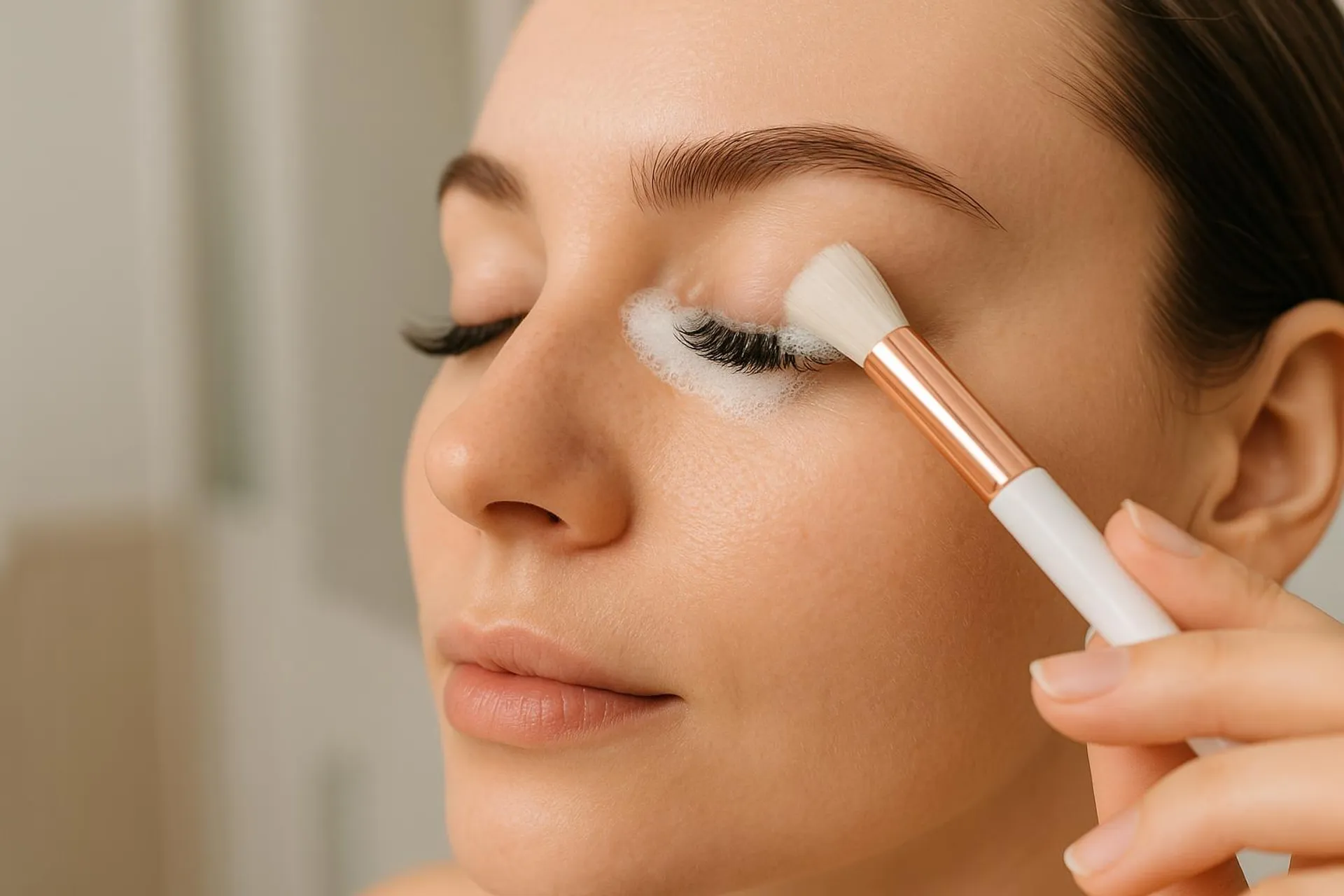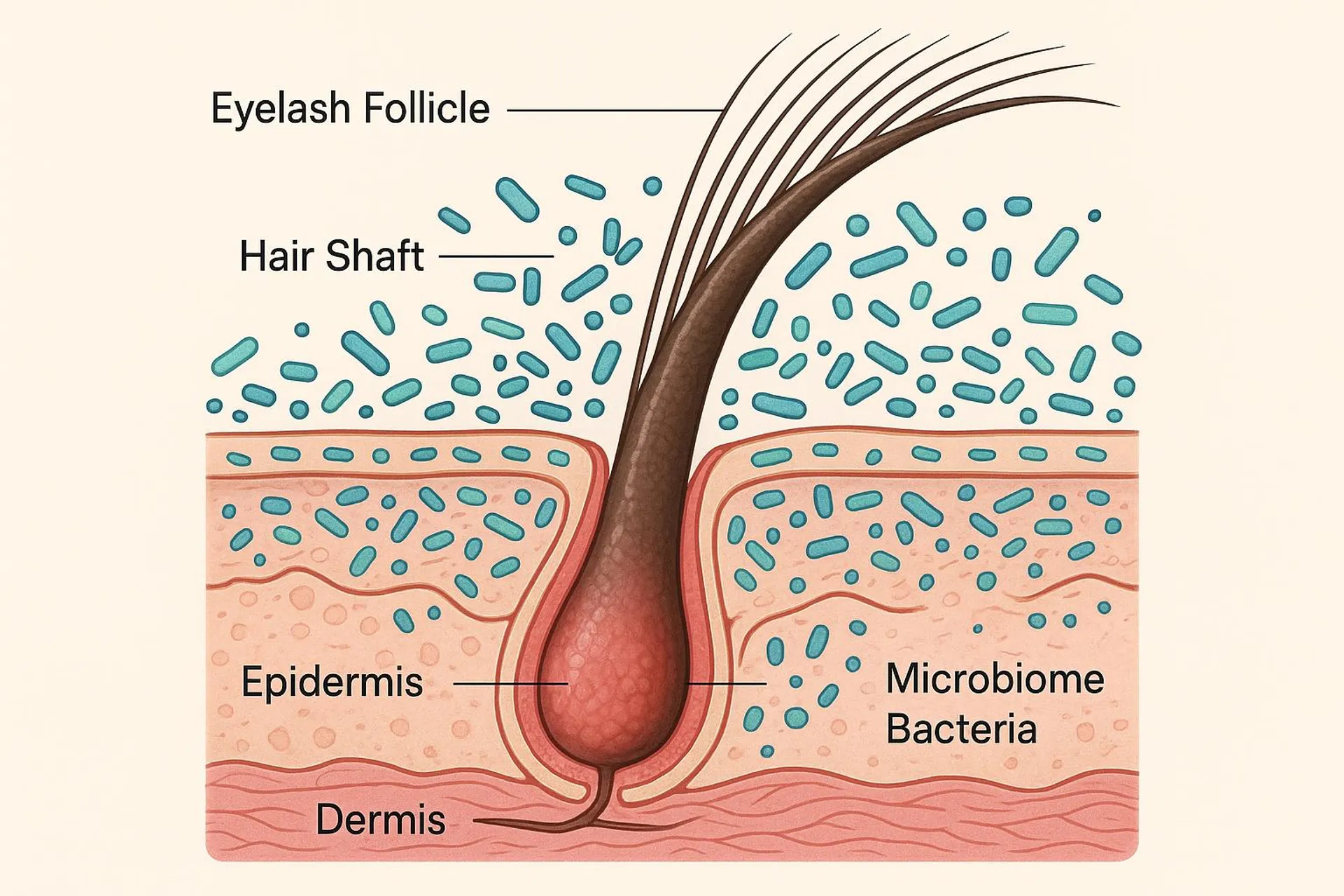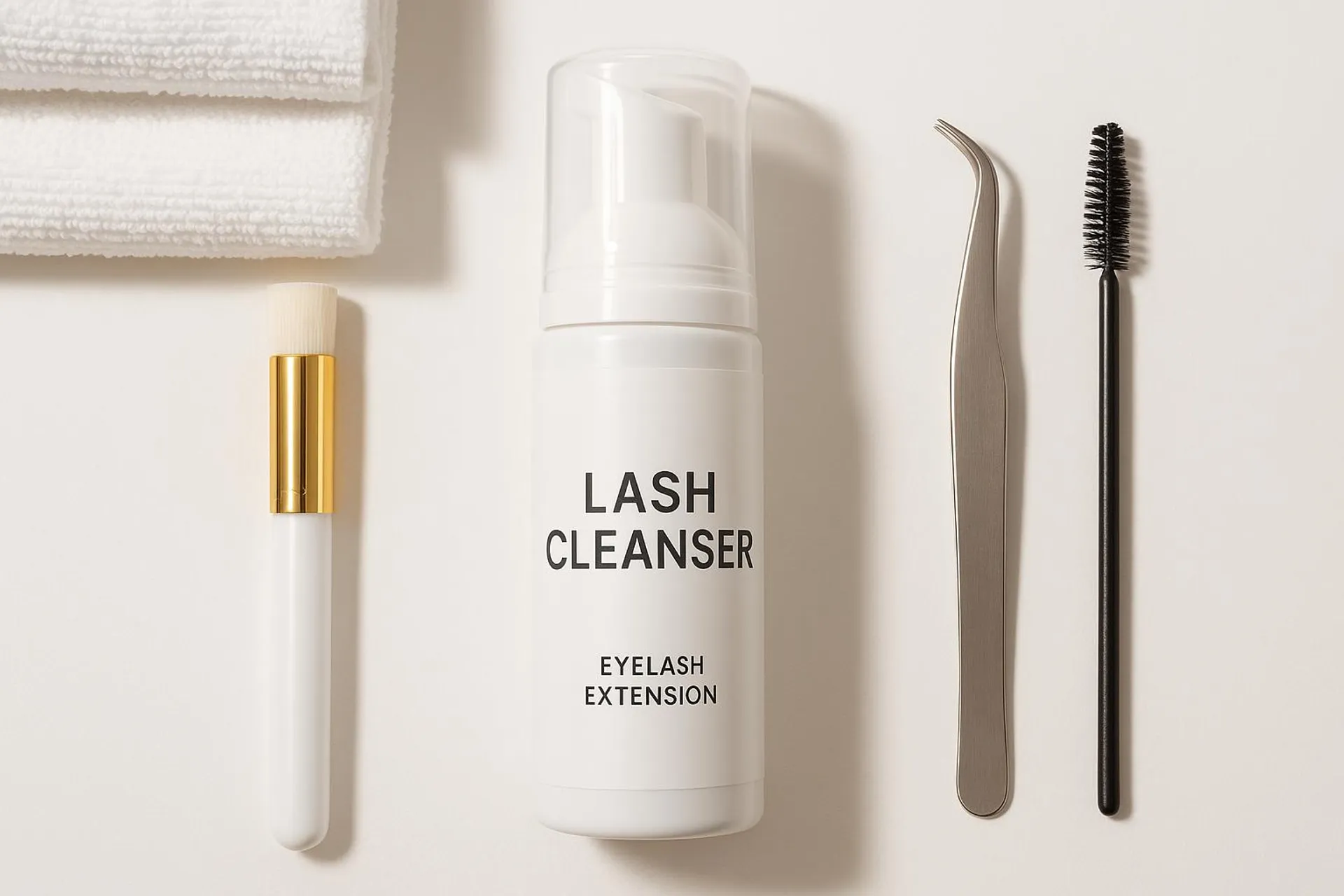Most people think about lash extensions in terms of aesthetics — length, curl, volume, and style. However, there is an entire microscopic world living on and around your eyelashes that plays a crucial role in the health, longevity, and safety of both your natural lashes and any extensions you wear. This hidden ecosystem, known as the lash microbiome, consists of bacteria, microscopic mites, oils, and other microorganisms that naturally inhabit the eyelash follicles and surrounding skin.
Understanding the science behind lash microbiome health is no longer just an academic curiosity — it has become essential knowledge for anyone who wears lash extensions or cares about maintaining healthy natural lashes. Recent research has revealed that improper lash hygiene can lead to an overgrowth of harmful bacteria and parasitic mites, resulting in conditions like blepharitis, meibomian gland dysfunction, and even premature lash loss. Conversely, maintaining a balanced, healthy lash microbiome through proper hygiene practices can dramatically improve lash retention, reduce irritation, and prevent serious eye health issues.
The good news is that armed with scientific knowledge about what is actually happening at the microscopic level of your lash line, you can implement simple but highly effective hygiene practices that protect your eye health while maximizing the beauty and longevity of your lashes. This guide explores the fascinating science of the lash microbiome, explains the most common problems that arise when this delicate ecosystem becomes imbalanced, and provides evidence-based strategies for maintaining optimal lash hygiene whether you wear extensions or not.
What Is the Lash Microbiome?
The term microbiome refers to the collection of microorganisms — including bacteria, fungi, viruses, and mites — that naturally live on and in the human body. According to the American Academy of Ophthalmology, the ocular surface and eyelid area have their own distinct microbiome that differs from other parts of the body. This lash microbiome exists in a delicate balance, with beneficial bacteria helping to protect against harmful pathogens while coexisting peacefully with your body.
Your eyelashes and the follicles they grow from provide a unique habitat for these microorganisms. The warm, slightly moist environment created by tears, oil production from meibomian glands, and the natural shedding of skin cells creates ideal conditions for microbial life. In a healthy lash microbiome, this ecosystem remains balanced, with no single organism dominating or causing problems. However, when this balance is disrupted — often due to poor hygiene, makeup buildup, or the introduction of foreign materials like lash extensions — certain organisms can proliferate and cause significant issues.
The Role of Beneficial Bacteria
Not all bacteria on your lashes are harmful. In fact, beneficial bacteria play an important protective role by competing with potentially pathogenic organisms for space and resources. These helpful microbes produce substances that inhibit the growth of harmful bacteria and help maintain the slightly acidic pH of the eyelid skin, which naturally discourages infection. When you use harsh cleansers or fail to clean your lashes regularly, you can disrupt this beneficial bacterial population, leaving your lash line vulnerable to colonization by problematic organisms.

Demodex Mites: The Microscopic Residents of Your Lashes
Perhaps the most surprising inhabitants of the lash microbiome are Demodex mites — tiny, eight-legged parasites that live in or near hair follicles on the face and eyelashes. UCLA Health research confirms that Demodex mites are a normal part of the body’s microbiome, with most adults harboring at least some of these microscopic creatures. In small numbers, Demodex mites are generally harmless and may even provide some benefit by consuming dead skin cells and excess oils.
There are two species of Demodex that commonly inhabit the eyelash area: Demodex folliculorum, which lives inside the hair follicles, and Demodex brevis, which resides in the oil glands. These mites are incredibly small — about 0.3 millimeters long — making them invisible to the naked eye. They emerge at night to mate on the skin surface, then return to the follicles during daylight hours. While this might sound disturbing, remember that in controlled numbers, these mites are a normal and usually harmless part of human biology.
When Demodex Becomes a Problem
The issue arises when Demodex mite populations grow out of control, a condition known as demodicosis. Research published in the National Institutes of Health database shows that Demodex overgrowth is strongly associated with blepharitis, an inflammatory condition of the eyelids that causes redness, itching, crusting, and discomfort. Studies have found that anywhere from 42% to 81% of people with blepharitis also have an infestation of Demodex mites.
Several factors can lead to Demodex overgrowth. Poor lash hygiene is the primary culprit, as accumulated oils, dead skin cells, and makeup residue provide abundant food for the mites and create an environment where they can reproduce rapidly. Lash extensions can exacerbate this problem if not properly maintained, as the extensions create additional surface area for mites to inhabit and can make thorough cleaning more challenging. Additionally, the natural decline in immune function that occurs with age makes older adults more susceptible to Demodex overgrowth.
Signs of Demodex Infestation
How do you know if you have a Demodex problem? Common symptoms include persistent itching at the base of the lashes, especially upon waking; crusty debris or cylindrical dandruff-like sleeves around individual lashes; red, inflamed eyelid margins; a gritty or burning sensation in the eyes; and unexplained lash loss. If you wear lash extensions and notice that they are falling out more quickly than expected, or if your natural lashes seem to be thinning, Demodex overgrowth could be a contributing factor.
It is worth noting that many people with mild Demodex overgrowth experience no symptoms at all, which is why preventive hygiene is so important. By the time symptoms become noticeable, the mite population may already be quite high and require more aggressive treatment to bring back under control.
Blepharitis and Bacterial Overgrowth
Blepharitis is one of the most common eye conditions affecting people who wear lash extensions, though it can occur in anyone with poor eyelid hygiene. This inflammatory condition occurs when the oil glands at the base of the eyelashes become clogged or infected, leading to red, swollen, itchy eyelids. Healthline reports that blepharitis from eyelash extensions is increasingly common as the popularity of lash extensions continues to grow.
There are two main types of blepharitis: anterior blepharitis, which affects the outside front of the eyelid where the eyelashes attach, and posterior blepharitis, which affects the inner edge of the eyelid that touches the eye. Both types can be caused or exacerbated by bacterial overgrowth, particularly Staphylococcus bacteria, which naturally live on the skin but can cause problems when they multiply excessively.
The Connection Between Extensions and Blepharitis
Lash extensions do not directly cause blepharitis, but they can create conditions that make it more likely to develop if proper hygiene is not maintained. The extensions trap oils, dead skin cells, makeup residue, and environmental debris close to the lash line, creating a breeding ground for bacteria. Additionally, many people with lash extensions are hesitant to clean them thoroughly, fearing they will damage or dislodge the extensions. This reluctance to clean properly is one of the biggest risk factors for developing blepharitis.
The adhesive used to attach lash extensions can also contribute to the problem if it is not applied correctly. Adhesive that touches the skin or accumulates at the base of the lashes can trap bacteria and prevent the natural shedding of skin cells and oils. Over time, this buildup creates an inflammatory response that manifests as blepharitis.
Preventing and Treating Blepharitis
The good news is that blepharitis is highly preventable with proper lash hygiene practices. Daily cleaning of the lash line with a specialized lash cleanser is the single most effective preventive measure. These cleansers are formulated to remove oils, debris, and bacteria without breaking down lash extension adhesive. For those who already have blepharitis, treatment typically involves more intensive cleaning routines, warm compresses to open clogged oil glands, and in some cases, prescription antibiotic ointments or oral medications.
If you develop symptoms of blepharitis while wearing lash extensions, it is important to see an eye care professional rather than trying to self-treat. In some cases, the extensions may need to be removed temporarily to allow the condition to heal. However, with proper treatment and improved hygiene practices, most people can continue wearing lash extensions without recurring problems.
Evidence-Based Lash Hygiene Practices
Understanding the science of the lash microbiome makes it clear why proper hygiene is non-negotiable for anyone who wears lash extensions or wants to maintain healthy natural lashes. The following evidence-based practices are recommended by eye care professionals and lash health experts to maintain a balanced, healthy lash microbiome.
Daily Lash Cleansing
The cornerstone of lash microbiome health is daily cleansing with a product specifically formulated for the eye area. Regular facial cleansers and makeup removers often contain oils or harsh detergents that can break down lash extension adhesive or irritate the delicate eye area. Professional lash cleansers are typically oil-free, pH-balanced, and designed to effectively remove debris and bacteria without damaging extensions.
To properly cleanse your lashes, dispense a small amount of lash cleanser onto a soft cleansing brush or clean fingertips. Gently work the cleanser along the lash line using small circular motions, making sure to clean both the top and bottom lash lines. Rinse thoroughly with water and pat dry with a clean, lint-free towel. This process should be performed at least once daily, preferably in the evening to remove the day’s accumulation of oils, makeup, and environmental debris. For those prone to blepharitis or Demodex issues, twice-daily cleansing may be recommended.
Proper Drying Techniques
After cleansing, it is crucial to ensure your lashes are completely dry. Moisture trapped at the base of lash extensions creates an ideal environment for bacterial and mite proliferation. Use a small fan, a cool setting on a hair dryer held at a safe distance, or a specialized lash dryer to gently air-dry your lashes after cleansing. Avoid rubbing your lashes with a towel, as this can cause premature shedding of both extensions and natural lashes.
Regular Professional Maintenance
Even with excellent at-home hygiene, professional lash maintenance appointments are important for microbiome health. During fill appointments, your lash artist can remove accumulated buildup that may be difficult to reach with at-home cleansing, check for signs of irritation or infection, and ensure that your extensions are not causing any damage to your natural lashes. Most lash artists recommend fill appointments every two to three weeks, which aligns well with the natural lash growth cycle and provides regular opportunities for professional cleaning and assessment.
For those interested in learning more about comprehensive lash care, our guide on eyelash extension aftercare provides detailed information on maintaining healthy lashes between salon visits.
Special Considerations for Extension Wearers
If you wear lash extensions, there are additional considerations for maintaining optimal lash microbiome health. First, be selective about the products you use near your eyes. Avoid oil-based makeup removers, heavy eye creams, and waterproof mascara on your extensions, as these products can trap bacteria and are difficult to remove completely. Choose water-based or specifically extension-safe products instead.
Second, resist the temptation to touch or rub your lashes throughout the day. Your hands carry bacteria that can be transferred to your lash line, and rubbing can damage both your extensions and natural lashes. If your eyes feel itchy or irritated, this may be a sign of developing blepharitis or Demodex overgrowth, and you should consult with your lash artist or eye care professional rather than simply scratching the itch.
When to Remove Extensions
While most people can wear lash extensions safely with proper hygiene, there are times when removal is the healthiest choice. If you develop persistent redness, swelling, discharge, or pain around your eyes, these are signs of infection that require immediate attention. Similarly, if you notice significant thinning or loss of your natural lashes, it may be time to take a break from extensions and focus on restoring your natural lash health.
Some people also find that certain life circumstances make maintaining proper lash hygiene more challenging. For example, if you are going through a period of illness, extreme stress, or major life changes that make daily cleansing difficult, it may be wise to remove your extensions temporarily rather than risk developing hygiene-related complications.
Natural Lash Health and Microbiome Balance
Even if you do not wear lash extensions, maintaining a healthy lash microbiome is important for the health and appearance of your natural lashes. Many of the same principles apply: daily gentle cleansing, avoiding harsh products, and being mindful of what you apply near your eyes. For those focused on natural lash health, incorporating nourishing oils and serums into your routine can support lash strength and growth while maintaining microbiome balance.
It is also worth noting that certain lifestyle factors affect lash microbiome health. Diet, stress levels, sleep quality, and overall immune function all play roles in maintaining the delicate balance of microorganisms on your lashes. A holistic approach to health that includes proper nutrition, adequate sleep, and stress management will support not just your lash microbiome but your overall eye health as well.
The Future of Lash Microbiome Research
The scientific understanding of the lash microbiome is still evolving, with new research continually revealing insights into how these microscopic ecosystems function and how they can be optimized for health. Recent studies have begun exploring how different lash extension materials and adhesives affect the microbiome, whether certain cleansing ingredients are more effective at controlling Demodex populations, and how the lash microbiome changes with age and hormonal fluctuations.
As this research progresses, we can expect to see more sophisticated lash care products and protocols designed specifically to support microbiome health. Some companies are already developing probiotic lash serums that introduce beneficial bacteria to help maintain balance, while others are researching antimicrobial lash extension materials that naturally resist bacterial colonization. The future of lash care will likely involve a much more nuanced understanding of the microscopic world living on our lashes and how to work with, rather than against, these natural ecosystems.
For now, the most important takeaway is that lash health extends far beyond what you can see with the naked eye. By understanding and respecting the complex microbiome that exists on your lashes, implementing proper hygiene practices, and staying informed about the latest research, you can enjoy beautiful, healthy lashes — whether natural or enhanced with extensions — while minimizing your risk of uncomfortable and potentially serious eye health issues. The microscopic world of your lashes may be invisible, but its impact on your eye health and lash longevity is very real and very significant.

